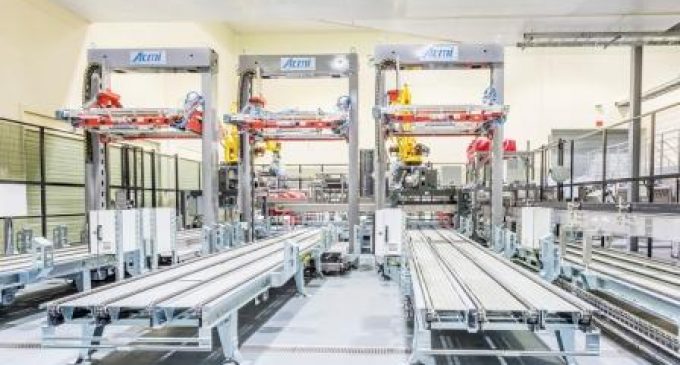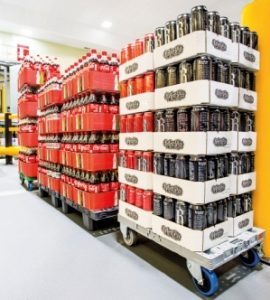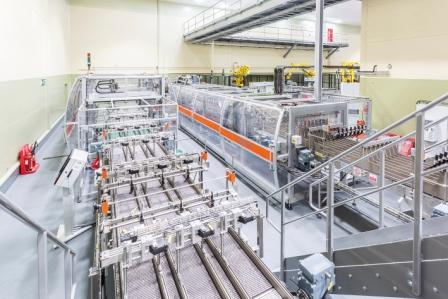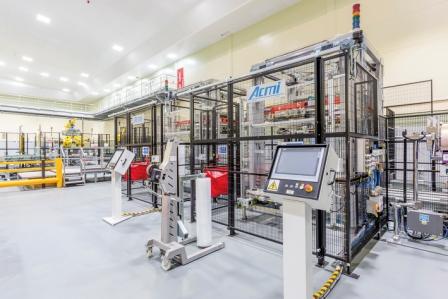ACMI Opens New Possibilities For Repacking!

Repacking is certainly not a new concept, but the technical innovations introduced by ACMI between 2015 and 2017 have opened new possibilities for repackaging, especially for soft drink makers. The line that ACMI will introduce, and which is actually in operation at one of the most important European plants of the Coca-Cola European Partners group, features high automation and greater flexibility both in the depalletising and repackaging phases, thus offering interesting solutions to the large international bottling groups.
Concept
This innovative repacking line allows many repackaging options ranging from three types of product: can packs, bottle packs, bulky PET bottles on shaped trays, bulky PET bottles on cardboard trays and bulky cans on cardboard trays. The main constraints to be met include the inability to simultaneously handle the three types of product listed above and the inability to change the original packaging with which the product enters the line (it is therefore not possible to extract the cans from the cans pack or repackage it passing, for example, from a 6×4 configuration to a 2×2 configuration). Since it is a so called ‘off-line system’, the production speed is lower than that of a traditional bottling line as speed is not the main element to assess this type of plant, but rather the flexibility in repacking combinations. Being equipped with three inbound loading stations, the line can mix up to three different flavours, palletising directly on pallets or on a tray.
The Line
Moving on to the description of the line from a technical point of view, it has an infeed system consisting of three independent loading stations. These stations consist of conveyor belts that transport the product pallets to the two depalletising robots equipped with special gripping heads. The gripping heads represent the focus of the entire depalletisation system which is able, on the one hand, to depallitise can packs and bottles by taking them ‘by row’ and, on the other, by means of an automatic exchange system from the head itself, to pick-up the bottles from the shaped plastic trays. The pick-up head is equipped with a camera system to correct any tray imperfections and always ensure perfect centring during the product pickup phase. Once depalletised, the two types of product, packs (of bottles or cans) and bulky bottles, follow two different paths, to meet again at the palletisation area.
Twisterbox and Traymax
The bottle or can packs coming from the three depalletisation lines, once depalletised, they proceed to the Twisterbox® layer formation system that, in addition to forming the layer, also mixes the flavours so as to deliver to the palletiser one layer of product with mixed flavours. However the Twisterbox can also handle only one flavour type when the purpose of the repacking line is to change the final pallet size moving for example, from a Europallet to one quarter tray. Not only, as the system is not only able to reduce the pallet size, but it can also insert the product layer into cardboard half and quarter trays, and then palletise them on pallets. In the case of tray package insertion, the Traymax tray former comes into play, another key element of this central part of the line which, logistically positioned alongside the Twisterbox, performs two functions: on the one hand it has the task of repacking bulky bottles (and also to mix their flavours, three at most) when the line is set up with this type of program and from the top it has the task of producing empty trays for palletising layers composed of packs (cans or PET bottles) produced by the Twisterbox.
Palletisation
The palletisation phase is entrusted to three Condor robots with specific gripping heads: the first, located at Twisterbox and Traymax outfeed, is equipped with a pick-up head with perimetric pads and inserts the product layer inside the trays produced by the Traymax (in this case the line can generate trays of the same flavour or with mixed flavours); the second, equipped with an openable platform head, palletises shrinkwrapped pack layers prepared by the Twisterbox, and the trays with bulk bottles prepared by Traymax tray former; the third robot, equipped with a special gripping head, manages and supplies pallets and interlayers that feed the palletising process.
Pallet stretch Wrapping
The line ends with a wrapping system consisting of three pallet stretch wrappers, capable of handling numerous combinations. The first two pallet stretch wrappers, positioned close to the palletisation area, are two Vortex 1000 fixed-pallet systems, whilst the third wrapper is a rotating table pallet stretch wrapper Rocket model. All three pallet stretch wrappers mount a one meter reel and are equipped with the ACMI patented electronic pre-stretching system (film pre-stretching value is above 400%) and the automatic change over system of the entire pre-stretching unit. The most complex configuration is that where the first Vortex pallet stretch wrapper wraps the pallet quarters, the second Vortex pallet stretch wrapper wraps the pallet quarters two by two thus generating a half pallet and the third and last pallet stretch wrapper wraps the two half pallets together once these have been placed on a “mother” pallet, generating a whole pallet. This is not a compulsory wrapping combination, but it is the one in which each machine wraps a different pallet size: quarter, half, full – if this is not flexibility!




































